唐敬博-201871010118 《面向对象程序设计(java)》第七周学习总结
在博客园撰写博客(随笔),总结7周实验内容,作业格式要求如下:
- 博文名称:学号-姓名《面向对象程序设计(java)》第七周学习总结(1分)
- 博文正文开头格式:(2分)
|
项目 |
内容 |
|
这个作业属于哪个课程 |
https://www.cnblogs.com/nwnu-daizh/ |
|
这个作业的要求在哪里 |
https://www.cnblogs.com/nwnu-daizh/p/11435127.html |
|
作业学习目标 |
|
随笔博文正文内容包括:
实验内容和步骤
实验1:(20分)
实验内容:在“System.out.println(...);”语句处按注释要求设计代码替换...,观察代码录入中IDE提示,以验证四种权限修饰符的用法
代码如下:
package ppp;
class Parent { private String p1 = "这是Parent的私有属性"; public String p2 = "这是Parent的公有属性"; protected String p3 = "这是Parent受保护的属性"; String p4 = "这是Parent的默认属性"; private void pMethod1() { System.out.println("我是Parent用private修饰符修饰的方法"); } public void pMethod2() { System.out.println("我是Parent用public修饰符修饰的方法"); } protected void pMethod3() { System.out.println("我是Parent用protected修饰符修饰的方法"); } void pMethod4() { System.out.println("我是Parent无修饰符修饰的方法"); }}class Son extends Parent{ private String s1 = "这是Son的私有属性"; public String s2 = "这是Son的公有属性"; protected String s3 = "这是Son受保护的属性"; String s4 = "这是Son的默认属性"; public void sMethod1() { System.out.println(p2);//分别尝试显示Parent类的p1、p2、p3、p4值 System.out.println("我是Son用public修饰符修饰的方法"); } private void sMethod2() { System.out.println("我是Son用private修饰符修饰的方法"); } protected void sMethod() { System.out.println("我是Son用protected修饰符修饰的方法"); } void sMethod4() { System.out.println("我是Son无修饰符修饰的方法"); } }public class Demo { public static void main(String[] args) { Parent parent=new Parent(); Son son=new Son(); parent.pMethod2(); //分别尝试用parent调用Paren类的方法、用son调用Son类的方法 }}package com.nwnu.demo1;
public class Parent { private String p1 = "这是Parent的私有属性"; public String p2 = "这是Parent的公有属性"; protected String p3 = "这是Parent受保护的属性"; String p4 = "这是Parent的默认属性"; private void pMethod1() { System.out.println("我是Parent用private修饰符修饰的方法"); } public void pMethod2() { System.out.println("我是Parent用public修饰符修饰的方法"); } protected void pMethod3() { System.out.println("我是Parent用protected修饰符修饰的方法"); } void pMethod4() { System.out.println("我是Parent无修饰符修饰的方法"); }}package com.nwnu.demo2;
import com.nwnu.demo1.Parent;public class Son extends Parent{ private String s1 = "这是Son的私有属性"; public String s2 = "这是Son的公有属性"; protected String s3 = "这是Son受保护的属性"; String s4 = "这是Son的默认属性"; public void sMethod1() { System.out.println(p2);//分别尝试显示Parent类的p1、p2、p3、p4值 System.out.println("我是Son用public修饰符修饰的方法"); } private void sMethod2() { System.out.println("我是Son用private修饰符修饰的方法"); } protected void sMethod() { System.out.println("我是Son用protected修饰符修饰的方法"); } void sMethod4() { System.out.println("我是Son无修饰符修饰的方法"); } }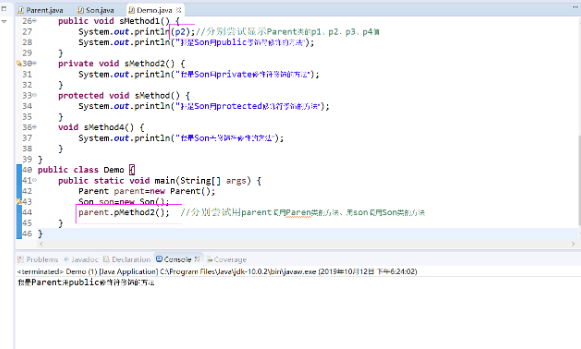
调用方法得到的结果:
调用方法四得到的结果;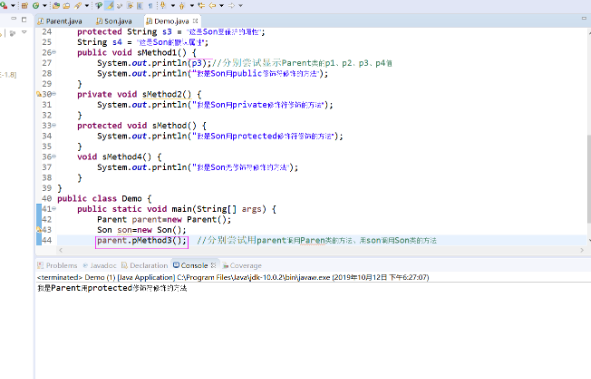

得到的结果: 权限控制表
修饰词 本类 同一个包的类 继承类 其他类
private √ × × ×
无(默认) √ √ × ×
protected √ √ √ ×
public √ √ √ √
实验2:测试程序1(15分)
l 运行教材程序5-8、5-9、5-10,结合程序运行结果理解程序(教材174页-177页);
实验代码如下:
1,package equals;
import java.time.*;import java.util.Objects;public class Employee{ private String name; private double salary; private LocalDate hireDay; public Employee(String name, double salary, int year, int month, int day) { this.name = name; this.salary = salary; hireDay = LocalDate.of(year, month, day); } public String getName() { return name; } public double getSalary() { return salary; } public LocalDate getHireDay() { return hireDay; } public void raiseSalary(double byPercent) { double raise = salary * byPercent / 100; salary += raise; } public boolean equals(Object otherObject) { // a quick test to see if the objects are identical if (this == otherObject) return true; //检查这些值是否相等 // must return false if the explicit parameter is null if (otherObject == null) return false; //如果显示参数为空,则返回false // if the classes don't match, they can't be equal if (getClass() != otherObject.getClass()) return false; //如果类不相等,则它们不匹配 // now we know otherObject is a non-null Employee Employee other = (Employee) otherObject; //otherObject 是一个非空雇员对象 // test whether the fields have identical values return Objects.equals(name, other.name) && salary == other.salary && Objects.equals(hireDay, other.hireDay); //检测它们是否具有相同的值 } public int hashCode() { return Objects.hash(name, salary, hireDay); } public String toString() { return getClass().getName() + "[name=" + name + ",salary=" + salary + ",hireDay=" + hireDay + "]"; }}2,package equals;public class Manager extends Employee //子类Manager类继承父类Employee类{ private double bonus; public Manager(String name, double salary, int year, int month, int day) //Manager构造器 { super(name, salary, year, month, day); bonus = 0; } public double getSalary() // { double baseSalary = super.getSalary(); return baseSalary + bonus; } public void setBonus(double bonus) { this.bonus = bonus; } public boolean equals(Object otherObject) { if (!super.equals(otherObject)) return false; //检查是否属于同一个类 Manager other = (Manager) otherObject; // super.equals checked that this and other belong to the same class return bonus == other.bonus; } public int hashCode() { return java.util.Objects.hash(super.hashCode(), bonus); } public String toString() { return super.toString() + "[bonus=" + bonus + "]"; }}package equals;
/** * This program demonstrates the equals method. * @version 1.12 2012-01-26 * @author Cay Horstmann */public class EqualsTest{ public static void main(String[] args) { Employee alice1 = new Employee("Alice Adams", 75000, 1987, 12, 15); Employee alice2 = alice1; Employee alice3 = new Employee("Alice Adams", 75000, 1987, 12, 15); Employee bob = new Employee("Bob Brandson", 50000, 1989, 10, 1); System.out.println("alice1 == alice2: " + (alice1 == alice2)); System.out.println("alice1 == alice3: " + (alice1 == alice3)); System.out.println("alice1.equals(alice3): " + alice1.equals(alice3)); System.out.println("alice1.equals(bob): " + alice1.equals(bob)); System.out.println("bob.toString(): " + bob); Manager carl = new Manager("Carl Cracker", 80000, 1987, 12, 15); Manager boss = new Manager("Carl Cracker", 80000, 1987, 12, 15); boss.setBonus(5000); System.out.println("boss.toString(): " + boss); System.out.println("carl.equals(boss): " + carl.equals(boss)); System.out.println("alice1.hashCode(): " + alice1.hashCode()); System.out.println("alice3.hashCode(): " + alice3.hashCode()); System.out.println("bob.hashCode(): " + bob.hashCode()); System.out.println("carl.hashCode(): " + carl.hashCode()); }}![]()
删除程序中Employee类、Manager类中的equals()、hasCode()、toString()方法,背录删除方法,在代码录入中理解类中重写Object父类方法的技术要点。
Employee类重写后代码如下:
package equals;
import java.time.*;
import java.util.Objects;
public class Employee
{
private String name; //实例域定义
private double salary;
private LocalDate hireDay;
public Employee(String name, double salary, int year, int month, int day)//构造器定义
{
this.name = name;
this.salary = salary;
hireDay = LocalDate.of(year, month, day);
}
public String getName() {
return name;
}
public double getSalary() {
return salary;
}
public LocalDate getHireDay() {
return hireDay;
}
public void raiseSalary(double byPercent)
{
double raise=salary*byPercent/100;
salary+=raise;
}
@Override
public boolean equals(Object otherObject) {
// TODO Auto-generated method stub
if(this==otherObject) return true;
if(this==null) return false;
if(getClass() != otherObject.getClass()) return false;
Employee other=(Employee)otherObject;
return Objects.equals(name,other.name)&&salary == other.salary&&Objects.equals(hireDay,other.hireDay);
}
@Override
public int hashCode() {
// TODO Auto-generated method stub
return Objects.hash(name,salary,hireDay);
}
@Override
public String toString() {
// TODO Auto-generated method stub
return getClass().getName()+"[name="+name+",salary="+salary+",hireday="+hireDay+"]";
}
}
Manager类重写之后代码如下:
package equals;
/**
* This program demonstrates the equals method.
* @version 1.12 2012-01-26
* @author Cay Horstmann
*/
public class EqualsTest
{
public static void main(String[] args)
{
Employee alice1 = new Employee("Alice Adams", 75000, 1987, 12, 15);
Employee alice2 = alice1;
Employee alice3 = new Employee("Alice Adams", 75000, 1987, 12, 15);
Employee bob = new Employee("Bob Brandson", 50000, 1989, 10, 1);
System.out.println("alice1 == alice2: " + (alice1 == alice2));
System.out.println("alice1 == alice3: " + (alice1 == alice3));
System.out.println("alice1.equals(alice3): " + alice1.equals(alice3));
System.out.println("alice1.equals(bob): " + alice1.equals(bob));
System.out.println("bob.toString(): " + bob);
Manager carl = new Manager("Carl Cracker", 80000, 1987, 12, 15);
Manager boss = new Manager("Carl Cracker", 80000, 1987, 12, 15);
boss.setBonus(5000);
System.out.println("boss.toString(): " + boss);
System.out.println("carl.equals(boss): " + carl.equals(boss));
System.out.println("alice1.hashCode(): " + alice1.hashCode());
System.out.println("alice3.hashCode(): " + alice3.hashCode());
System.out.println("bob.hashCode(): " + bob.hashCode());
System.out.println("carl.hashCode(): " + carl.hashCode());
}
}
(3)EmployeeTest类代码如下:
package equalspublic class Manager extends Employee{
private double bonus;
public Manager(String name, double salary, int year, int month, int day) {
super(name, salary, year, month, day);
// TODO Auto-generated constructor stub
bonus = 0;
}
public void setBonus(double bonus) {
this.bonus = bonus;
}
@Override
public double getSalary() {
// TODO Auto-generated method stub
double baseSalary= super.getSalary();
return baseSalary+bonus;
}
@Override
public boolean equals(Object otherObject) {
// TODO Auto-generated method stub
if(!super.equals(otherObject)) return false;
Manager other=(Manager)otherObject;
return bonus==other.bonus;
}
@Override
public int hashCode() {
// TODO Auto-generated method stub
return super.hashCode()+17*new Double(bonus).hashCode();
}
@Override
public String toString() {
// TODO Auto-generated method stub
return super.toString()+"[bonus="+bonus+"]";
}
}
运行结果如下:
实验2:测试程序2(15分)
l 在elipse IDE中调试运行程序5-11(教材182页),结合程序运行结果理解程序;
l 掌握ArrayList类的定义及用法;
l 在程序中相关代码处添加新知识的注释;
实验代码如下:
package arrayList;
import java.util.*;
/**
* This program demonstrates the ArrayList class.
* @version 1.11 2012-01-26
* @author Cay Horstmann
*/
public class ArrayListTest
{
public static void main(String[] args)
{
// fill the staff array list with three Employee objects
ArrayList<Employee> staff = new ArrayList<Employee>();
staff.add(new Employee("Carl Cracker", 75000, 1987, 12, 15));
staff.add(new Employee("Harry Hacker", 50000, 1989, 10, 1));
staff.add(new Employee("Tony Tester", 40000, 1990, 3, 15));
// raise everyone's salary by 5%
for (Employee e : staff)
e.raiseSalary(5);
// print out information about all Employee objects
for (Employee e : staff)
System.out.println("name=" + e.getName() + ",salary=" + e.getSalary() + ",hireDay="
+ e.getHireDay());
}
}
(2)
package arrayList;
import java.time.*;
public class Employee
{
private String name;
private double salary;
private LocalDate hireDay;
public Employee(String name, double salary, int year, int month, int day)
{
this.name = name;
this.salary = salary;
hireDay = LocalDate.of(year, month, day);
}
public String getName()
{
return name;
}
public double getSalary()
{
return salary;
}
public LocalDate getHireDay()
{
return hireDay;
}
public void raiseSalary(double byPercent)
{
double raise = salary * byPercent / 100;
salary += raise;
}
}
运行结果如下:
实验2:测试程序3(15分)
l 编辑、编译、调试运行程序5-12(教材189页),结合运行结果理解程序;
l 掌握枚举类的定义及用法;
l 在程序中相关代码处添加新知识的注释;
实验代码如下:
package enums;
import java.util.*;
/**
* This program demonstrates enumerated types.
* @version 1.0 2004-05-24
* @author Cay Horstmann
*/
public class EnumTest
{
public static void main(String[] args)
{
Scanner in = new Scanner(System.in);
System.out.print("Enter a size: (SMALL, MEDIUM, LARGE, EXTRA_LARGE) ");
String input = in.next().toUpperCase();
Size size = Enum.valueOf(Size.class, input);
System.out.println("size=" + size);
System.out.println("abbreviation=" + size.getAbbreviation());
if (size == Size.EXTRA_LARGE)
System.out.println("Good job--you paid attention to the _.");
}
}
enum Size
{
SMALL("S"), MEDIUM("M"), LARGE("L"), EXTRA_LARGE("XL");
private Size(String abbreviation) { this.abbreviation = abbreviation; }
public String getAbbreviation() { return abbreviation; }
private String abbreviation;
}
运行结果如下:
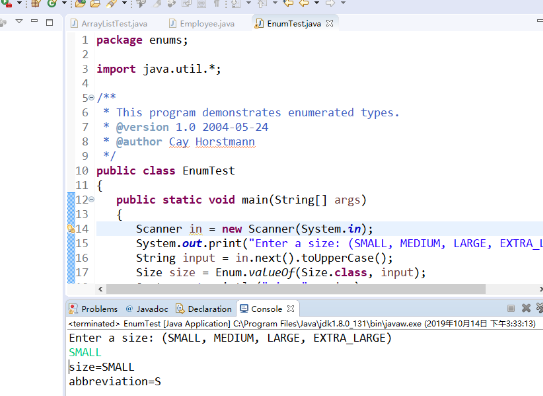
实验2:测试程序4(5分)
录入以下代码,结合程序运行结果了解方法的可变参数用法
public class TestVarArgus {
public static void dealArray(int... intArray){
for (int i : intArray)
System.out.print(i +" ");
System.out.println();
}
public static void main(String args[]){
dealArray();
dealArray(1);
dealArray(1, 2, 3);
}
}
运行结果如下:
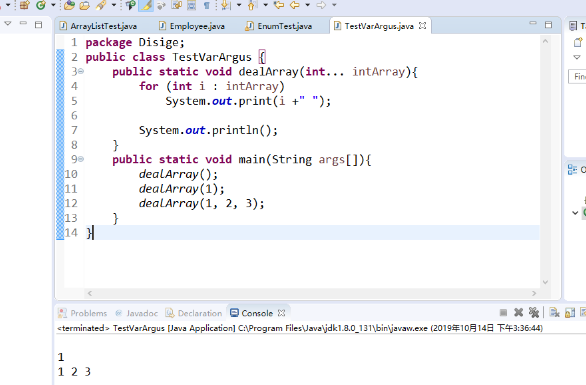
实验3:编程练习(10分)
代码如下:
public class Demo {
public static void main(String[] args) { Son son = new Son(); son.method(); }}class Parent { Parent() { System.out.println("Parent's Constructor without parameter"); } Parent(boolean b) { System.out.println("Parent's Constructor with a boolean parameter"); } public void method() { System.out.println("Parent's method()"); }}class Son extends Parent {//补全本类定义 Son(){ super(false); System.out.println("Son's Constructor without parameter"); } public void method() { System.out.println("Son's method()"); super.method(); }}
运行结果:
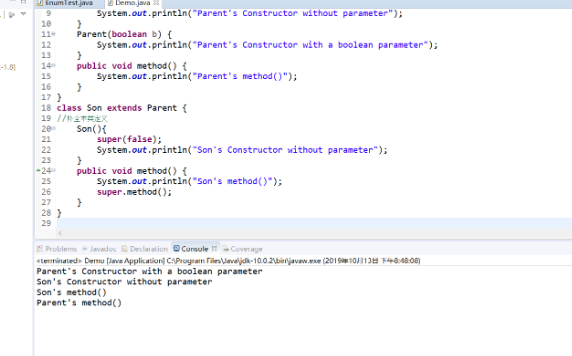
3. 实验总结:(15分)
我觉得在学习理论知识时,可以跟着老师的思路,觉得已经掌握了知识点,但在实验过程中发现自己还是不会运用,肯平时没有多看书,对基础知识掌握不到位。对于老师设计的简单编程题,由于自己的知识还不够,因此几乎不能独立的做出完整的实验。所以在以后的学习中,我会多看翁恺老师的视频以及老师的课件来学习编程,来写出完整的程序。





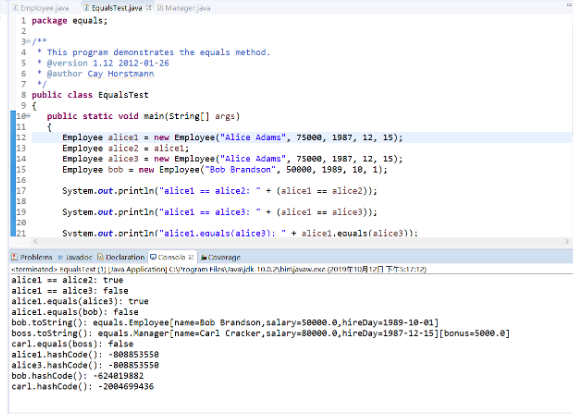

 浙公网安备 33010602011771号
浙公网安备 33010602011771号